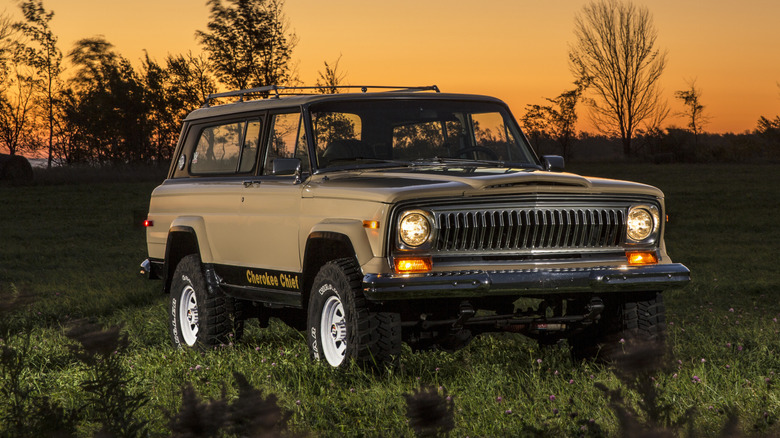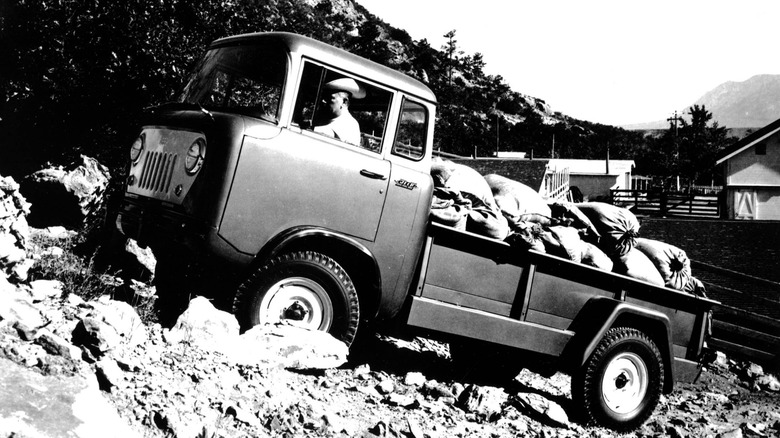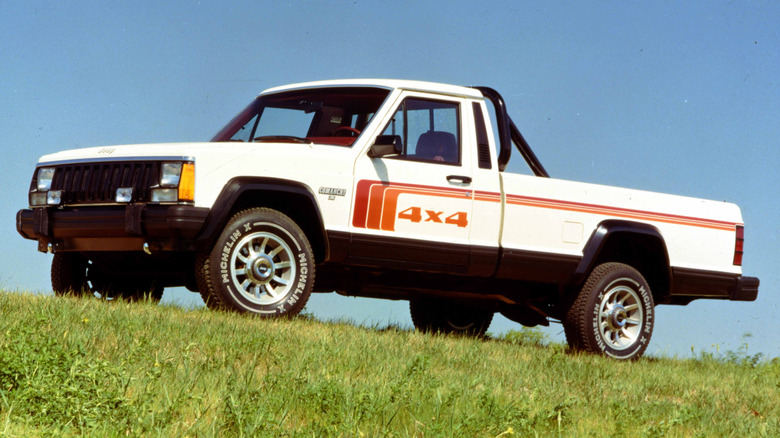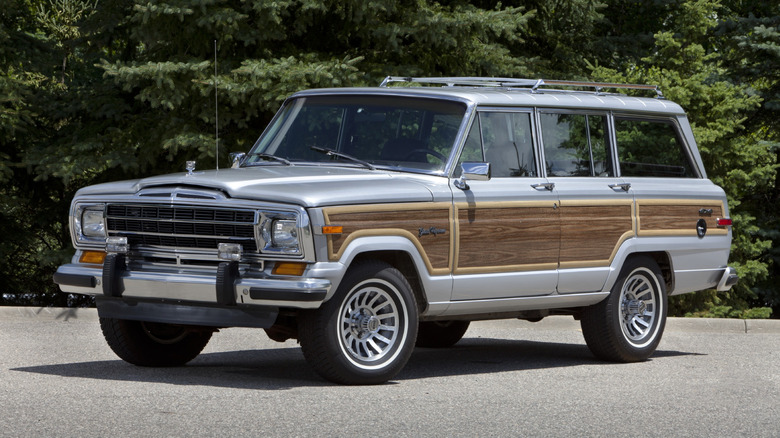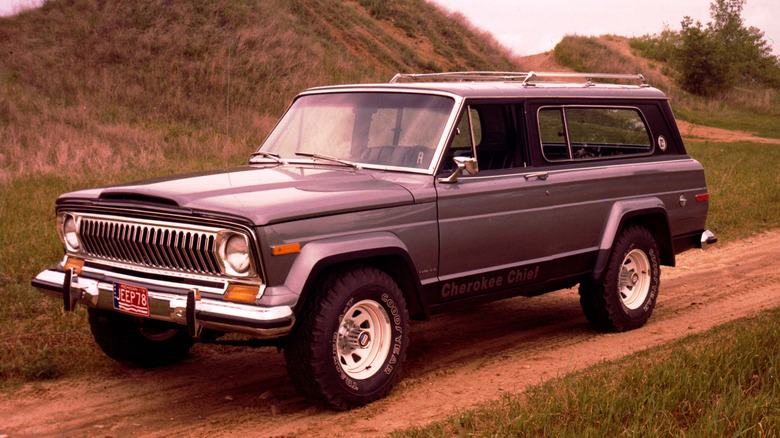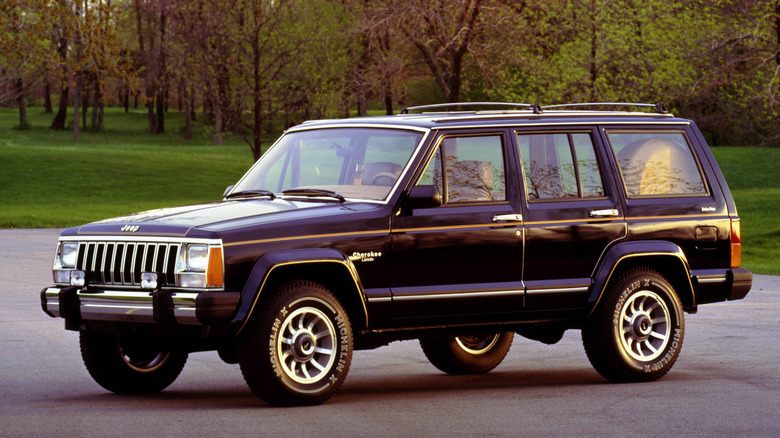These 5 Discontinued Jeep Models Deserve A Modern Revival
Jeep has been hard at work creating off-roaders with adventure aspirations for an impressive 85 years. Back in 1940, the focus was on rugged military vehicles for World War II, and while the modern Wrangler hasn't strayed too far from that original formula, Jeep is not immune to auto industry trends like electrification and greater efficiency. The 2025 lineup contains vehicles, like the Wagoneer S, that would have been hard to imagine back in the day.
And as you might expect, with a history stretching back so far, the Jeep brand is littered with discontinued models that have been deemed irrelevant to present-day consumers. But what if you could bring back some of those Jeep legends from the dead for a modern-day reboot? The possibilities are nearly endless and over the years, Jeep has teased fans with famed monikers applied to concept cars. However, if we had to choose a roster of discontinued Jeep models that deserve a revival, these nameplates would be at the top of the list.
Forward Control
The oldest of our discontinued Jeep models, the funny-looking Forward Control dates to the late 1950s. Unconventional at best and scarily nose-heavy at worst, the Forward Control — FC for short — has the unfortunate distinction of being an all-time worst-selling pickup truck. However, I'd argue the FC was simply ahead of its time. Today, Jeep's portfolio has a single pickup truck in the Gladiator, so it's line could use a little fleshing out. We'll get to an excellent option for a compact model shortly, but how about a modern battery-powered FC?
Jeep is already selling an EV with the new Wagoneer S, so it could in theory drop that powertrain under a new FC pickup. It would solve the original truck's issues with being too heavy up front and broaden Jeep's appeal among EV-focused buyers. As for its funky styling, get a load of the ID.Buzz from Volkswagen. Not quite as flat-faced as the old school Jeep FC, it is in the same vein. The late Ford Transit Connect, with its massive panoramic windshield, offers another case study on the merits of this approach to vehicle design.
A rebooted Jeep FC would bring some needed freshness to the pickup truck segment. Jeep already tossed the idea around with its Mighty FC concept in 2012 and the crowd went wild. The market is there, now we just need Jeep to take the plunge.
Comanche
While we're on the topic of Jeep pickups, allow me to finish completing the automaker's modern-day lineup with a revived Comanche. Unlike the Gladiator, which is based on the Wrangler and comes with the associated "benefits" of removable body panels and a truck-like ride, the long-gone Comanche was a derivative of the Cherokee. Built between 1986 and 1992, we've called the Comanche one of the best-looking Jeeps ever made, particularly in its Eliminator guise, which came with sweet graphics and even sweeter 10-hole cast aluminum wheels.
Were Jeep to bring it back to life, the Comanche could make a fine competitor to the Ford Maverick. How it is that the Maverick continues to sell in a segment of one remains a mystery, one that could be solved with a new Comanche. Surely Jeep could find a competitive platform within the massive Stellantis universe that could go head-to-head with the Maverick and in the process, kick-start a dedicated Jeep pickup truck lineup.
Circa 1986, the Comanche was only sold as a regular cab, so the modern version would likely need a crew cab to be relevant. But the original model also briefly offered a small turbodiesel powertrain with 85 hp and a manual transmission. If Jeep brought that configuration back with a focus on fuel efficiency and perhaps a smidge more output, it's hard to imagine any scenario other than a raging sales success.
SJ Grand Wagoneer
The current Grand Wagoneer's bloated land yacht footprint, high falutin' price tag, and luxury Palermo leather digs may seem new territory for the Jeep lineup, but today's Grand Wagoneer is in fact a reboot. Going back to 1984, Jeep was ahead of all comers in the jet-set SUV game with the original Grand Wagoneer. Featuring glorious woodgrain body panels, a big V8, and "supple leather," the SJ Grand Wagoneer was sold to buyers with median incomes around $200,000 in today's dollars.
Period ads with gentlemen in tuxedos and ladies in fur coats certainly supported this mentality. While the 2025 Grand Wagoneer is certainly capable off-road, chances seem slim that anyone riding around in a fully loaded $117,000 SUV with 22-inch all-season rubber is going to hit up the Rubicon over the weekend. Which is where the SJ version comes in. Bring it back for 2025, but as a retro-styled true off-roader. Jeep has already played around with positioning the current Grand Wagoneer and its lesser, regular Wagoneer sibling as a sub-brand without a Jeep badge.
It didn't, ahem, stick, but perhaps a third spoke in the Wagoneer lineup could justify this move permanently. Ford has leaned into the retro vibe with its full-size Bronco and baby Bronco Sport via touches like white wheels and wacky body graphics. Jeep could do the same thing — with faux wood trim and a more dedicated off-road intent — all while returning an icon to the lineup.
SJ Cherokee
In my armchair expert quest to fully reimagine Jeep's present-day lineup, I shall now divulge my master plan for yet another sub-brand: the Cherokee. A legend if ever there was one, the XJ — coming next — is a personal favorite, a personal first car, and an all-around awesome machine. However, before the XJ there was the SJ Cherokee. Sharing a platform with the original Wagoneer/Grand Wagoneer family, the Cherokee nameplate first saw production in 1974 as a sporty, lower-cost variant of the two-door Wagoneer.
A response to the Chevy Blazer, it took the timeless Brooks Stevens Wagoneer design and elevated it with smaller side windows and a fatter C pillar, much like the International Scout. Then, in 1976, the Cherokee Chief was unveiled with fender flares and wide-track axles for serious brawn. The white wide-slot wheels, all-terrain tires, and body graphics were all part of its "tough performance" marketing, all of which was aided by an available 401 cubic inch V8 powertrain.
Bringing it back to life today, the reborn two- and four-door SJ Cherokee could compete against the multitude of current off-road heroes like Toyota's Land Cruiser and the Ford Bronco, ideally with old school trim lines like Golden Eagle. In the newly formed Cherokee lineup, this would be the hardcore full-size variant, the incoming 2026 Cherokee could be whatever it's going to be, and an all-new XJ Cherokee could give the Compass the boot in favor of something truly exciting.
XJ Cherokee
The ultimate discontinued Jeep rebirth, the XJ Cherokee was perfectly styled with trim dimensions and a continental appearance courtesy of AMC's collaboration with Renault at the time. But, arguably, its best bit was the torquey 4.0-liter straight-six that made 190 hp and 235 lb-ft of torque by the end of production.
Renowned for low-end grunt and capable of taking the Cherokee from 0-60 in 8.4 seconds, we've called this engine one of the most reliable straight sixes ever made. An added dose of cool factor came from the five-speed manual transmission with its long-throw shifter. Now, I realize the stick may be tough for Jeep to revive in 2025, but the Hurricane family of inline-6 engines is a shoo-in for an XJ revival and the old XJ had unibody construction, like so many modern-day platforms, making a rebirth that much easier.
Ever since Jeep canned the XJ series in 2001, the Cherokee has never been the same. The magic was lost during the past three generations of Cherokee production and though an all-new model is coming next year, it's unlikely to be a true successor to the XJ. So, if Jeep was feeling inspired, it could drop the Compass and replace it with a new XJ Cherokee that would serve to bolster the Cherokee brand and, hopefully, bring back some of that simple, boxy Jeep magic.
